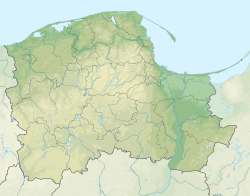Great stone graves near Siemirowice
| Great stone graves near Siemirowice Great stone graves near Schimmerwitz | ||
|---|---|---|
|
|
||
| Coordinates | Siemirowice 1 , Siemirowice 2 , Siemirowice 3 , Siemirowice 4 , Siemirowice 5 , Siemirowice 6 , Siemirowice 7 | |
| place | Gmina Cewice OT Siemirowice , Pomerania , Poland | |
| Emergence | 3500 to 2800 BC Chr. | |
| Sprockhoff no. | 598-604 | |
The megalithic graves near Siemirowice (also called megalithic graves near Schimmerwitz ) are a group of seven megalithic tombs of the Neolithic funnel cup culture near Siemirowice ( German Schimmerwitz ), a district of Gmina Cewice (German Zewitz ) in the Pomeranian Voivodeship in Poland . They have the Sprockhoff numbers 598–604.
location
The graves are located southwest of Siemirowice in a forest area. They are located in an east-west row on the south side of the road to Oskowo (German Wutzkow ). In the same forest area there are about 150 burial mounds , some of which date back to the earlier Bronze Age.
description
Grave 1
The complex has a northeast-southwest oriented oval mound made of stones the size of a head, 8 m long and 6 m wide. The centrally located burial chamber has the same orientation. It originally consisted of three pairs of wall stones on the long sides and a capping stone each on the narrow sides. Ernst Sprockhoff noted the north-eastern end stone, the three wall stones on the north-western side and one wall stone on the south-eastern long side when he took the picture in 1934. The northernmost stone on the northwest side had tipped inside the chamber. A piece of the stone on the southeast side had been blasted off. The chamber has a length of 2.5 m, a width of 1.2 m and a height of 0.7 m.
Grave 2
The complex has a north-west-south-east oriented mound made of stones the size of a head with a length of 6.5 m, a width of 5 m and a preserved height of 0.5 m. The burial chamber has the same orientation. It originally consisted of two pairs of wall stones on the long sides and a capping stone each on the narrow sides. When Sprockhoff took the picture, the north-western end stone, the adjoining wall stone on the southwest side and the two wall stones on the northeast side were preserved. The two remaining wall stones and the cap stones were missing. The chamber can probably be addressed as an extended dolmen .
Grave 3
According to Sprockhoff, the facility has a short, almost north-south oriented trapezoidal barren bed with almost the same length and width. When Sprockhoff took the picture, it was almost completely enclosed on the east and south sides. Furthermore, a stone on the northwest corner and another stone on the north side were preserved. Only remnants were left of the mound. In the south part of the bed there is an east-west oriented burial chamber, of which Sprockhoff found three wall stones on the long sides. The end and cap stones were missing. The chamber has a length of 2.5 m and a width of 0.7 m.
Grave 4
Grave 4 has a mound still preserved in remains. When he took the picture, Sprockhoff found seven larger stones, which are the remains of a burial chamber, probably oriented northeast-southwest, which originally consisted of two pairs of wall stones on the long sides, one end stone each on the narrow sides and two cap stones; it can therefore be addressed as an extended dolmen. The north-eastern end stone and an adjoining wall stone were still in situ when Sprockhoff took the picture, the remaining stones were lying around in a mess.
Grave 5
With this system, Sprockhoff was only able to determine the southern end of what was probably a north-south orientated megalithic bed. There were still seven surrounding stones on the southern narrow side and a larger stone slab 1.4 m long and 1.1 m wide on the south-east corner, which might have covered a burial chamber.
Grave 6
Grave 6 is very badly damaged. When Sprockhoff took the picture, there were still five stones left, which are probably the remains of a burial chamber with probably two cap stones.
Grave 7
Grave 7 is badly damaged and when Sprockhoff took it, it was so heavily covered with stones that precise documentation was not possible.
literature
- Ernst Sprockhoff : Atlas of the megalithic tombs of Germany. Part 2: Mecklenburg - Brandenburg - Pomerania. Rudolf-Habelt Verlag, Bonn 1967, pp. 101-102.
